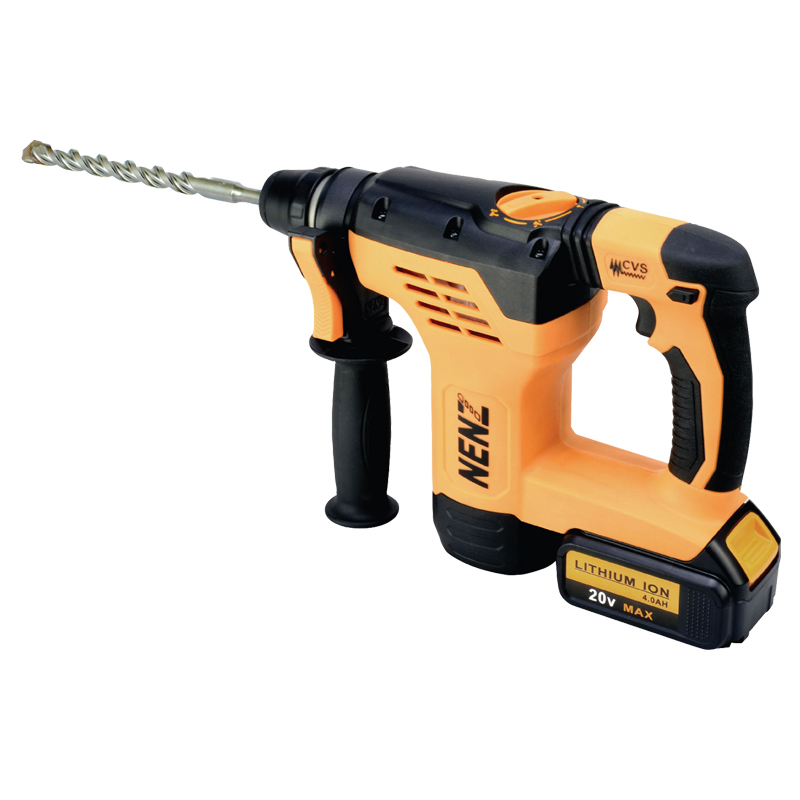About rotary hammer
Date:2016-12-12
Lower power units are usually called "hammer drills," typically have a "cam-action" or "percussion" hammering mechanism, in which two sets of toothed gears mechanically interact with each other to hammer while rotating the drill bit. With "cam-action" drills, the chuck has a mechanism whereby the entire chuck and bit move forward and backwards on the axis of rotation, the motion is tied to the rotation of the chuck. This type of drill is often used with and without the hammer action but it is not possible to use the hammer action alone as it is the rotation over the "cams" which causes the hammer motion. These units are usually smaller and are commonly powered by cordless technology. They are not typically used for production construction drilling, but rather for occasional drilling of concrete or masonry.
More advanced power units, usually labeled rotary hammers, tend to be larger and provide a bigger impact force by utilizing a technology called the "electro-pneumatic" (EP) hammering mechanism," because it is powered directly by electricity, instead of a separate air compressor. An EP hammer has two pistons—a drive piston, and a flying piston. An electric motor turns a crank, which moves the drive piston back and forth in a cylinder. The flying piston is at the other end of the same cylinder. The pistons do not actually touch, but the air pressure in the EP cylinder allows for a much more efficient transfer of hammering energy than springs in the cam-action style tools. The majority of modern rotary hammers as well as all electric-powered chipping guns or jack-hammers all utilize this EP technology. Modern units allow the hammer and rotation functions to be used separately or in combination, i.e., hammer mode, drill mode, or both. When used in the hammer mode, the tool provides a drilling function similar to a jackhammer.
Hammer drills of both working principles are well suited for drilling holes in masonry or stone. They are also both used to drill holes in concrete footings to pin concrete wall forms and to drill holes in concrete floors to pin wall framing. Larger rotary hammers can also be used for "doweling" (repetitive drilling of large rebar anchor holes), and through-holes in concrete and masonry walls. The hammering action helps to break up the masonry so that it can be removed by the drill bit's flutes.

More advanced power units, usually labeled rotary hammers, tend to be larger and provide a bigger impact force by utilizing a technology called the "electro-pneumatic" (EP) hammering mechanism," because it is powered directly by electricity, instead of a separate air compressor. An EP hammer has two pistons—a drive piston, and a flying piston. An electric motor turns a crank, which moves the drive piston back and forth in a cylinder. The flying piston is at the other end of the same cylinder. The pistons do not actually touch, but the air pressure in the EP cylinder allows for a much more efficient transfer of hammering energy than springs in the cam-action style tools. The majority of modern rotary hammers as well as all electric-powered chipping guns or jack-hammers all utilize this EP technology. Modern units allow the hammer and rotation functions to be used separately or in combination, i.e., hammer mode, drill mode, or both. When used in the hammer mode, the tool provides a drilling function similar to a jackhammer.
Hammer drills of both working principles are well suited for drilling holes in masonry or stone. They are also both used to drill holes in concrete footings to pin concrete wall forms and to drill holes in concrete floors to pin wall framing. Larger rotary hammers can also be used for "doweling" (repetitive drilling of large rebar anchor holes), and through-holes in concrete and masonry walls. The hammering action helps to break up the masonry so that it can be removed by the drill bit's flutes.

 +86-769-23192489
+86-769-23192489







 Our Amazon Shop
Our Amazon Shop  Tel: +86-769-23192489-617
Tel: +86-769-23192489-617